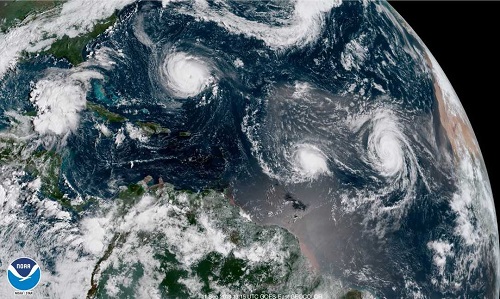Despite significantly elevated levels of catastrophe losses in both 2017 and 2018, analysts at Fitch Ratings state that increased policyholders’ surplus during this period supports its view that U.S. property and casualty (P&C) insurers are well placed to manage a significant landfalling storm.
 The 2019 Atlantic hurricane season officially started on Saturday June 1st, with the NOAA’s Climate Prediction Center’s latest outlook forecasting a 40% chance of a near-normal season.
The 2019 Atlantic hurricane season officially started on Saturday June 1st, with the NOAA’s Climate Prediction Center’s latest outlook forecasting a 40% chance of a near-normal season.
The NOAA predicts a likely range of 9 to 15 named storms, of which 4 to 8 could become hurricanes, including 2 to 4 major hurricanes. It predicts these ranges with 70% confidence.
For insurers and reinsurers, the number of landfalling storms and their intensity are more important than the number of storms actually forecast, and with the trio ( hurricanes Harvey, Irma, and Maria) of U.S. landfalling storms in 2017, combined with the significant impacts of hurricane Florence and Michael in 2018, re/insurers will be all too aware that it only takes one major landfalling event to drive substantial industry losses.
Fitch Ratings notes that while forecasts for the number of storms can be fairly accurate, determining the number of landfalling events and their intensity remains extremely uncertain.
Chris Grimes, Director of Insurance, Fitch Ratings, commented: “Given insurers’ substantial capital positions, it would likely take a record individual storm loss or a confluence of significant loss events, which could include catastrophes, investment losses and adverse loss reserve experience to impair insurers enough to warrant downgrades.”
According to Fitch, aggregate U.S. industry policyholders’ surplus increased by 6.2% over 2017 and 2018 to $757 billion, as of year-end 2018.
Potentially exacerbating losses in the state Florida is population growth and also rising coastal property values, as the trend of more and more people living in catastrophe-prone zones, such as the Florida coastline, is seemingly on the rise despite the potential social and economic devastation.
However, Fitch notes that the recently passed AoB legislation in the state of Florida could reduce the impact if abuse of homeowners policies moderates claims costs for underwriters, ultimately resulting in lower loss adjustment expenses. While these savings could be passed back to policyholders, it’s uncertain if any savings will ultimately impact reinsurance pricing, said Fitch.
Regarding reinsurance, Fitch expects traditional reinsurance capital to remain strong in 2019, supported by the fact the market has showed its resilience to the high levels of catastrophe losses experienced in recent years. At the same time, Fitch highlights the continued growth of the alternative reinsurance capital market, which, despite a slowdown in 2019 continues to claim a larger slice of the overall reinsurance market pie.


